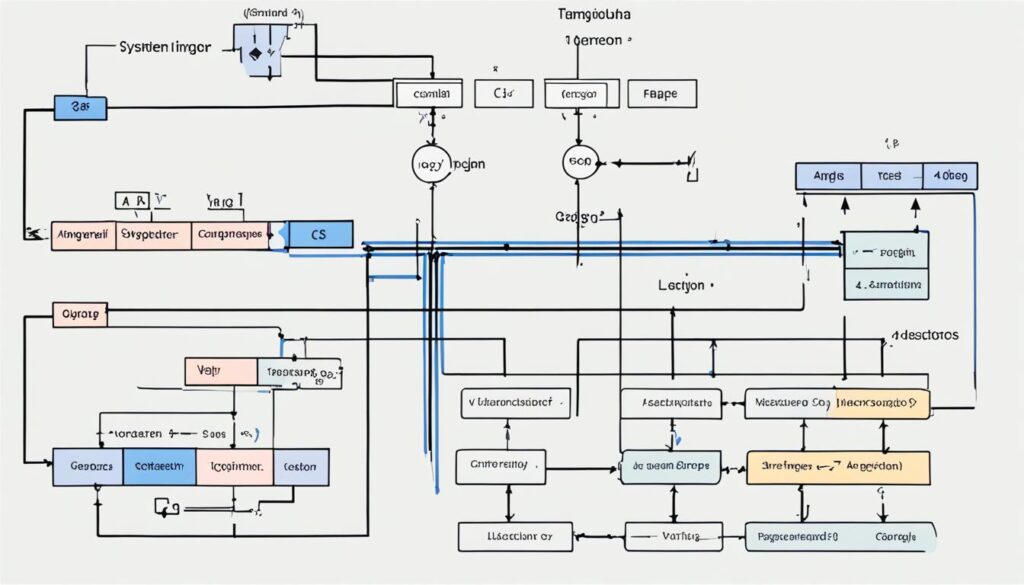Welcome to our article on System Tasks in Verilog! In this comprehensive guide, we will delve into the world of System Tasks and explore their significance in efficient simulation and debugging of HDL designs. By understanding the concept of System Tasks and their application, designers can leverage these powerful tools to enhance the functionality of Verilog and optimize their overall performance.
Whether you are a seasoned Verilog professional or just starting your journey in HDL design, this article will provide valuable insights into the different types of System Tasks commonly used. We will discuss how System Tasks facilitate simulation, capturing and manipulating data, and how they play a vital role in the accuracy and efficiency of the simulation process.
Additionally, we will explore the role of System Tasks in debugging HDL designs, enabling designers to monitor and analyze circuit behavior during simulation effectively. By leveraging System Tasks, designers can identify and resolve issues efficiently, streamlining the development process.
Furthermore, we will dive into advanced techniques and methodologies using System Tasks in Verilog. We will discuss their utilization for functional coverage analysis, performance evaluation, and design optimization.
To ensure you make the most of System Tasks in your Verilog designs, we will provide a set of best practices. These guidelines will help you effectively incorporate System Tasks, ensuring proper usage, and avoiding common pitfalls.
In conclusion, System Tasks are essential tools in Verilog that enable designers to enhance simulation and debugging processes. By leveraging the capabilities of System Tasks effectively and following best practices, designers can streamline the development of HDL designs and optimize their overall performance.
Table of Contents
Understanding System Tasks
In Verilog, System Tasks are a vital component that enhances the functionality and efficiency of HDL (Hardware Description Language) designs. These special tasks serve specific purposes and offer valuable capabilities during simulation and debugging processes. To gain a comprehensive understanding of System Tasks in Verilog, let’s explore their concept, purpose, and application.
System Tasks in Verilog are predefined functions that provide built-in functionality and streamline the development process. These tasks are designed to facilitate various operations and actions, such as reporting messages, performing time delays, and terminating simulation. By leveraging System Tasks, designers can simplify complex tasks, improve code readability, and enhance simulation accuracy.
There are different types of System Tasks commonly used in Verilog, each serving a specific function. These tasks include $display, $monitor, $time, $stop, and many others. Each task offers unique capabilities and advantages, which can be utilized to effectively analyze, monitor, and manipulate simulation data.
Commonly Used System Tasks in Verilog
1. $display: This System Task allows designers to output messages and display values during simulation. It provides a convenient way to print information and debug the behavior of the circuit.
2. $monitor: With the $monitor task, designers can continuously monitor the values of specific variables or conditions. It automatically displays the updated values whenever a change occurs, enabling real-time observation and analysis.
3. $time: The $time task provides the simulation time in the form of a 64-bit integer. Designers can utilize this task to track the progress of simulation and analyze the timing behavior of their designs.
4. $stop: The $stop task allows designers to halt the simulation at a specific point. It is commonly used for debugging purposes, enabling designers to pause the simulation and inspect the state of the circuit at a desired moment.
These are just a few examples of the System Tasks available in Verilog. Depending on the requirements of the design and simulation, designers can utilize different System Tasks to achieve their desired outcomes and effectively debug their HDL designs.
Overall, understanding System Tasks is essential for proficient Verilog programming. These tasks provide valuable functionalities that simplify simulation, aid in debugging, and enhance the overall efficiency of the design process. By leveraging the power of System Tasks, designers can streamline their workflows, improve code quality, and accelerate the development of robust HDL designs.
Simulation Using System Tasks
Simulation is a critical aspect of the design verification process in Verilog. It allows designers to assess the functionality and performance of their HDL designs before fabrication. System Tasks play a crucial role in facilitating the simulation process and ensuring accurate results.
System Tasks in Verilog provide predefined functions and procedures that simplify the capturing and manipulation of simulation data. These tasks are built-in and can be directly invoked in the testbench to perform specific actions during simulation.
One of the key advantages of utilizing System Tasks for simulation is their ability to interact with the design under test (DUT) and capture dynamic data at specific points in the simulation. This data can then be used for analysis, debugging, and verification purposes.
For example, the $display System Task allows designers to output messages and values to the simulation console, providing valuable insight into the behavior and state of the DUT at different time intervals. This helps in identifying potential issues, monitoring signals, and verifying the correctness of the design’s operation.
Manipulating Simulation Data
In addition to capturing data, System Tasks also enable designers to manipulate simulation data during runtime. This is particularly useful for conducting tests, applying stimuli, and verifying proper functionality.
Verilog provides various System Tasks to modify the input values of signals, control the timing of events, and create custom waveforms. Tasks such as $random and $monitor allow designers to generate random numbers and monitor signal value changes, respectively, enhancing the flexibility and effectiveness of the simulation process.
By using System Tasks to simulate realistic scenarios and apply diverse test vectors, designers can ensure comprehensive validation of their HDL designs, improving the robustness and reliability of the final product.
Accuracy and Efficiency
The integration of System Tasks in Verilog greatly enhances the accuracy and efficiency of the simulation process. By leveraging these tasks, designers can easily inspect the internal state of the DUT at critical time points and validate its behavior against expected results.
The ability to capture and manipulate simulation data using System Tasks reduces the complexity of testbenches, allowing for more concise and streamlined test cases. This results in faster simulation runs and quicker identification of potential issues, ultimately speeding up the overall design verification process.
Furthermore, System Tasks provide designers with a higher level of control and observability during simulation, enabling them to gain valuable insight into the functioning of their HDL designs. This visibility is crucial for identifying and resolving bugs and ensuring the correctness of the design implementation.
Overall, the utilization of System Tasks in simulation offers significant benefits in terms of accuracy, efficiency, and design verification. By incorporating these tasks effectively in the testbench, designers can optimize their simulation workflows and achieve reliable results in a shorter timeframe.

| Benefits of Simulation Using System Tasks in Verilog |
|---|
| Simplified capturing and manipulation of simulation data |
| Enhanced accuracy and efficiency in design verification |
| Improved control and observability during simulation |
| Streamlined test cases and faster simulation runs |
Debugging with System Tasks
When it comes to debugging HDL designs in Verilog, System Tasks play a pivotal role. These tasks provide designers with crucial tools to monitor and analyze the behavior of their circuits during simulation, enabling the identification and resolution of issues effectively.
With System Tasks, designers can gain insights into the inner workings of their designs, allowing for a deeper understanding of how different components interact and behave. By strategically placing System Task statements within the Verilog code, designers can collect and display valuable information during the simulation, helping to pinpoint potential bugs and troubleshooting them efficiently.
One of the most commonly used System Tasks for debugging is the `$display` task. This task allows designers to print out specific values or messages to the console during simulation, providing real-time feedback on the circuit’s behavior. By strategically placing `$display` statements at key points in the code, designers can track the values of important signals or variables, ensuring they are behaving as expected.
Another powerful System Task for debugging is the `$monitor` task. This task continuously monitors the value of a signal or set of signals and automatically displays their changes during simulation. By using `$monitor` in conjunction with the appropriate signal conditions, designers can track the behavior of critical signals and quickly detect any aberrations or unexpected behavior.
Example:
module example_module(
input wire clk,
input wire reset,
output reg [7:0] data_out
);
always @(posedge clk or posedge reset) begin
if (reset) begin
data_out
In the example above, we have a simple Verilog module that increments a data output on each positive clock edge, except during a reset condition where the output is set to zero. By using System Tasks, we can print a message whenever the reset condition is triggered (`$display`) and continuously monitor the value of `data_out` (`$monitor`). This allows us to observe and validate the behavior of our circuit during simulation.
Benefits of Debugging with System Tasks
Debugging with System Tasks offers several advantages:
- Real-time feedback: System Tasks allow designers to receive real-time information about their circuit’s behavior during simulation, aiding in the identification of issues promptly.
- Efficient troubleshooting: By strategically placing System Task statements, designers can quickly locate and resolve potential bugs, reducing debugging time and effort.
- Insights into circuit behavior: System Tasks enable designers to gain valuable insights into how different components of the circuit interact and behave, improving overall understanding and facilitating effective debugging strategies.
By leveraging the capabilities of System Tasks for debugging, designers can streamline the development process and ensure the reliability and effectiveness of their HDL designs.

| System Task | Function |
|---|---|
| $display | Prints specific values or messages to the console during simulation. |
| $monitor | Continuously monitors the value of a signal or set of signals and displays their changes during simulation. |
Advanced Techniques with System Tasks
In this section, we will delve into the realm of advanced techniques and methodologies using System Tasks in Verilog. These techniques provide designers with powerful tools to optimize their designs, evaluate performance, and ensure comprehensive functional coverage.
Functional Coverage Analysis
One of the key aspects of designing robust HDL designs is achieving comprehensive functional coverage. By utilizing System Tasks in Verilog, designers can efficiently capture and track the coverage of different scenarios and conditions within their designs. This allows for better validation and verification, ensuring that all possible design behaviors are thoroughly tested.
Performance Evaluation
System Tasks in Verilog also enable designers to evaluate the performance of their designs in a more precise and efficient manner. By using specialized System Tasks, designers can collect runtime data and measure critical performance metrics such as timing, power consumption, and resource utilization. This information provides valuable insights for optimizing design performance and meeting project requirements.
Design Optimization
Another significant application of System Tasks in Verilog is design optimization. By leveraging System Tasks, designers can analyze and optimize critical sections of their designs, identify potential bottlenecks, and implement targeted improvements. System Tasks enable designers to gather real-time data during simulation, allowing for a thorough analysis of design performance and the identification of optimization opportunities.
Overall, the advanced techniques and methodologies utilizing System Tasks in Verilog empower designers to build more robust, efficient, and optimized HDL designs. By applying these techniques, designers can ensure comprehensive functional coverage, evaluate and improve design performance, and optimize their designs for maximum efficiency.
| Advanced Techniques | Benefits |
|---|---|
| Functional Coverage Analysis | Ensures comprehensive testing of design behaviors |
| Performance Evaluation | Enables measurement and optimization of critical performance metrics |
| Design Optimization | Identifies and improves critical sections of the design |
Best Practices for Using System Tasks
In order to effectively utilize System Tasks in Verilog, it is important to follow a set of best practices that facilitate seamless integration into your design and ensure proper usage. By adhering to these guidelines, you can optimize the functionality and performance of your HDL designs. Let’s explore some of the key best practices for working with System Tasks:
1. Understand the Purpose and Functionality
Before incorporating System Tasks into your Verilog code, take the time to thoroughly understand their purpose and functionality. System Tasks are predefined functions that perform specific actions and provide useful information during simulation and debugging. Familiarize yourself with the different types of System Tasks available and their appropriate usage in different scenarios.
2. Use System Tasks Sparingly
While System Tasks offer valuable functionalities, it is important to use them sparingly and only when necessary. Overutilization of System Tasks can lead to bloated code and reduced simulation performance. Evaluate each instance where a System Task is used and ensure it adds significant value to your design.
3. Select Appropriate System Tasks
Choose the System Tasks that are most appropriate for your specific design requirements. Not all System Tasks will be relevant in every situation. Consider the functionalities you need and select the System Tasks that align with those needs. This will help eliminate unnecessary overhead and streamline your code.
4. Pay Attention to Timing
System Tasks often have specific timing requirements, especially when used in conjunction with other simulation events. It is crucial to take these timing constraints into account and ensure proper synchronization. Failure to do so can result in inaccurate simulation results or undefined behavior.
5. Handle Simulation Data Appropriately
When using System Tasks to manipulate simulation data, be mindful of data handling procedures. Follow best practices for data management, such as using appropriate data types and avoiding data corruption. Additionally, ensure that the System Tasks are used in a way that accurately captures and reflects the behavior of your design.
6. Test and Verify System Tasks
Prior to integrating System Tasks into your production code, thoroughly test and verify their functionality. Create targeted test cases that adequately cover different scenarios and variations. This will help you identify any potential issues or discrepancies and ensure that the System Tasks perform as intended.
7. Document System Task Usage
Document the usage of System Tasks within your codebase. Provide clear and concise explanations for each System Task implementation, describing its purpose, inputs, and expected outputs. This documentation will serve as a valuable resource for future developers working on the codebase and aid in maintaining code readability and scalability.
8. Stay Updated with Verilog Standards
Keep yourself updated with the latest Verilog standards and best practices related to System Tasks. Verilog evolves over time, and new functionalities may be introduced or existing functionalities may be enriched. Stay informed about these updates to ensure that you are leveraging System Tasks effectively and efficiently.
9. Leverage Community Resources
Tap into the wealth of knowledge and resources available within the Verilog community. Participate in forums, discussion groups, and online communities where Verilog experts share their experiences and insights. Engaging with the Verilog community can help you stay up-to-date with the latest trends, troubleshooting techniques, and innovative uses of System Tasks.
By following these best practices, you can harness the power of System Tasks in Verilog and optimize your design process. Utilizing System Tasks effectively not only improves simulation and debugging efficiency but also enhances the overall quality and performance of your HDL designs.
Conclusion
In conclusion, System Tasks play a crucial role in Verilog, enabling designers to enhance simulation and debugging processes. By leveraging the capabilities of System Tasks effectively and following best practices, designers can streamline the development of HDL designs and optimize their overall performance.

